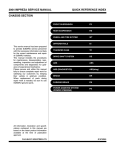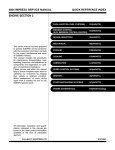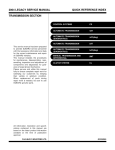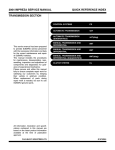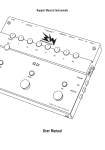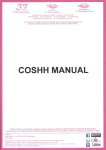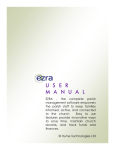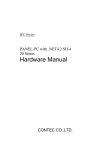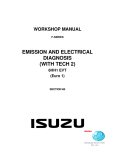Download 2003 LEGACY SERVICE MANUAL QUICK REFERENCE INDEX
Transcript
2003 LEGACY SERVICE MANUAL
QUICK REFERENCE INDEX
BODY SECTION
This service manual has been prepared
to provide SUBARU service personnel
with the necessary information and data
for the correct maintenance and repair
of SUBARU vehicles.
This manual includes the procedures
for maintenance, disassembling, reassembling, inspection and adjustment of
components and diagnostics for guidance of experienced mechanics.
Please peruse and utilize this manual
fully to ensure complete repair work for
satisfying our customers by keeping
their vehicle in optimum condition.
When replacement of parts during
repair work is needed, be sure to use
SUBARU genuine parts.
All information, illustration and specifications contained in this manual are
based on the latest product information
available at the time of publication
approval.
FUJI HEAVY INDUSTRIES LTD.
HVAC SYSTEM
(HEATER, VENTILATOR AND A/C)
AC
HVAC SYSTEM (DIAGNOSTICS)
AC
AIRBAG SYSTEM
AB
AIRBAG SYSTEM (DIAGNOSTICS)
AB
SEAT BELT SYSTEM
SB
LIGHTING SYSTEM
LI
WIPER AND WASHER SYSTEMS
WW
ENTERTAINMENT
ET
COMMUNICATION SYSTEM
COM
GLASS/WINDOWS/MIRRORS
GW
BODY STRUCTURE
BS
INSTRUMENTATION/DRIVER INFO
IDI
SEATS
SE
SECURITY AND LOCKS
SL
SUNROOF/T-TOP/CONVERTIBLE TOP
(SUNROOF)
SR
EXTERIOR/INTERIOR TRIM
EI
EXTERIOR BODY PANELS
EB
EXTERIOR/INTERIOR TRIM
EI
G2300GE7
2003 LEGACY SERVICE MANUAL
QUICK REFERENCE INDEX
BODY SECTION
CRUISE CONTROL SYSTEM
CC
CRUISE CONTROL SYSTEM
(DIAGNOSTICS)
CC
IMMOBILIZER (DIAGNOSTICS)
IM
G2300GE7
CRUISE CONTROL SYSTEM (DIAGNOSTICS)
CC
1.
2.
3.
4.
5.
6.
7.
8.
Page
Basic Diagnostic Procedure ........................................................................2
General Description ....................................................................................4
Electrical Components Location..................................................................7
Cruise Control Module I/O Signal................................................................8
Subaru Select Monitor...............................................................................10
Diagnostics Chart with Symptom ..............................................................12
List of Diagnostic Trouble Code (DTC) .....................................................26
Diagnostics Chart with Trouble Code........................................................27
BASIC DIAGNOSTIC PROCEDURE
CRUISE CONTROL SYSTEM (DIAGNOSTICS)
1. Basic Diagnostic Procedure
A: PROCEDURE
1
Step
Value
START DIAGNOSIS.
Cruise main switch is turned
1) Perform pre-inspection. <Ref. to CC-6,
ON.
INSPECTION, General Description.>
2) Check cruise control main switch operation.
Is cruise control main switch turned ON?
Yes
Go to step 2.
PREPARE SUBARU SELECT MONITOR.
Is the Subaru select monitor available?
PERFORM CRUISE CANCEL CONDITIONS
DIAGNOSIS.
Perform cruise cancel conditions diagnosis.
<Ref. to CC-10, Subaru Select Monitor.>
Is trouble code indicated?
Subaru select monitor is avail- Go to step 3.
able.
Trouble code is not indicated. Go to step 4.
4
CHECK CRUISE CONTROL SET OPERATION.
Check cruise control set operation.
Can cruise control be set while driving at 40
km/h (25 MPH)?
Cruise control can be set.
Go to step 5.
5
CHECK VEHICLE SPEED IS HELD WITHIN
SET SPEED.
Make sure vehicle speed is held within set
speed.
Is vehicle speed held within set speed ±3 km/h
(±2 MPH) ?
CHECK RESUME/ACCEL OPERATION.
Check RESUME/ACCEL operation.
Does vehicle speed increase or return to set
speed after RESUME/ACCEL switch has been
pressed?
Vehicle speed is held within
set speed.
Go to step 6.
Vehicle speed increases or
returns to set speed.
Go to step 7.
2
3
6
7
CHECK SET/COAST OPERATION.
Check SET/COAST operation.
Does vehicle speed decrease after SET/
COAST switch has been pressed?
Vehicle speed decreases.
Go to step 8.
8
Cruise control is released.
CHECK CANCEL OPERATION.
Check CANCEL operation.
Is cruise control released after CANCEL switch
has been pressed?
Go to step 9.
9
CHECK CRUISE CONTROL RELEASE OP- Cruise control is released.
ERATION.
Check cruise control release operation.
Is cruise control released after brake pedal has
been depressed?
Go to step 10.
CC-2
No
Go to symptom 1.
<Ref. to CC-12,
SYMPTOM
CHART, Diagnostics Chart with
Symptom.>
Go to step 4.
Go to “List of Diagnostic Trouble
Code (DTC)”.
<Ref. to CC-26,
List of Diagnostic
Trouble Code
(DTC).>
Go to symptom 2.
<Ref. to CC-12,
SYMPTOM
CHART, Diagnostics Chart with
Symptom.>
Go to symptom 3.
<Ref. to CC-12,
SYMPTOM
CHART, Diagnostics Chart with
Symptom.>
Go to symptom 4.
<Ref. to CC-12,
SYMPTOM
CHART, Diagnostics Chart with
Symptom.>
Go to symptom 5.
<Ref. to CC-12,
SYMPTOM
CHART, Diagnostics Chart with
Symptom.>
Go to symptom 6.
<Ref. to CC-12,
SYMPTOM
CHART, Diagnostics Chart with
Symptom.>
Go to symptom 7.
<Ref. to CC-12,
SYMPTOM
CHART, Diagnostics Chart with
Symptom.>
BASIC DIAGNOSTIC PROCEDURE
CRUISE CONTROL SYSTEM (DIAGNOSTICS)
10
Step
CHECK CRUISE CONTROL RELEASE OPERATION.
Check cruise control release operation.
Is cruise control released after clutch pedal
has been depressed? (MT)
Value
Cruise control is released.
CC-3
Yes
Finish the diagnostics.
No
Go to symptom 8.
<Ref. to CC-12,
SYMPTOM
CHART, Diagnostics Chart with
Symptom.>
GENERAL DESCRIPTION
CRUISE CONTROL SYSTEM (DIAGNOSTICS)
2. General Description
A: CAUTION
1. SUPPLEMENTAL RESTRAINT SYSTEM
“AIRBAG”
Airbag system wiring harness is routed near the
cruise control module and cruise control command
switch.
CAUTION:
• All airbag system wiring harness and connectors are colored yellow. Do not use electrical test equipment on these circuits.
• Be careful not to damage airbag system wiring harness when servicing the cruise control
module and cruise control command switch.
CC-4
GENERAL DESCRIPTION
CRUISE CONTROL SYSTEM (DIAGNOSTICS)
B: PREPARATION TOOL
1. SPECIAL TOOLS
ILLUSTRATION
TOOL NUMBER
24082AA210 (Newly
adopted tool)
DESCRIPTION
CARTRIDGE
REMARKS
Troubleshooting for electrical systems.
22771AA030
SUBARU SELECT
MONITOR KIT
Troubleshooting for electrical systems.
• English:
22771AA030 (Without printer)
• German:
22771AA070 (Without printer)
• French:
22771AA080 (Without printer)
• Spanish:
22771AA090 (Without printer)
ST24082AA210
ST22771AA030
2. GENERAL TOOLS
TOOL NAME
Circuit Tester
REMARKS
Used for measuring resistance, voltage and ampere.
CC-5
GENERAL DESCRIPTION
CRUISE CONTROL SYSTEM (DIAGNOSTICS)
C: INSPECTION
5. CABLE FREE PLAY
1. BATTERY
Measure battery voltage and specific gravity of
electrolyte.
Standard voltage:
12 V, or more
(C)
Specific gravity:
Above 1.260
(D)
(B)
2. CRUISE CONTROL CABLE
(A)
CC-00037
Check that the clearance (A) between throttle cam
(B) and lever or cable deflection (D) is within specifications.
(A)
Throttle cam-to-lever clearance:
0 — 1 mm (0 — 0.04 in)
Inner cable deflection:
1 — 8 mm (0.04 — 0.31 in)
If NG, adjust the clearance or the deflection with
the adjust nut.
(B)
CC-00156
Check the cruise control cable (B) installation.
If NG, install the cable securely.
NOTE:
Check that the cap (C) is positioned in the groove.
3. ACCELERATOR CABLE
(A)
(B)
CC-00156
Check movement of the accelerator cable (A) when
the cruise control throttle is moved by hand.
If NG, check throttle cam.
4. THROTTLE CAM
Check that the throttle cam moves smoothly.
If NG, repair throttle cam.
CC-6
ELECTRICAL COMPONENTS LOCATION
CRUISE CONTROL SYSTEM (DIAGNOSTICS)
3. Electrical Components Location
A: LOCATION
(1)
(2)
(4)
(3)
(5)
(7)
(6)
CC-00095
(1) Actuator
(2) Inhibitor switch (AT)
(3) Cruise control command switch
(4) Cruise control main switch
(5) Clutch switch (MT)
(6) Stop and brake switch
(7) Cruise control module
NOTE:
Electrical component locations are for LHD vehicles.
Cruise control actuator and cruise control module locations for RHD vehicles are symmetrically opposite.
Cruise control main switch location is different depending on destination.
CC-7
CRUISE CONTROL MODULE I/O SIGNAL
CRUISE CONTROL SYSTEM (DIAGNOSTICS)
4. Cruise Control Module I/O Signal
A: ELECTRICAL SPECIFICATION
10
9
8
7
6
5
4
3
2
1
20 19 18 17 16 15 14 13 12 11
CC-00075
Content
Main light
Terminal No.
1
Inhibitor switch (AT)
4
Motor B
5
Ground
Motor A
6
7
RESUME/ACCEL switch
9
SET/COAST switch
10
Main power supply
11
Ignition switch
12
Motor C
13
Motor clutch
14
Cruise control main switch
15
Brake switch
16
Data link connector
Data link connector
17
18
Measuring conditions and I/O signals (ignition switch ON and engine idling)
• Battery voltage is present when main switch is turned OFF.
• “0” volt is present when main switch is turned ON.
• Battery voltage is present when selector lever is other than “P” or “N” position.
• “0” volt is present when selector lever is set to “P” or “N” position.
• ON-and-OFF (“0”-and-battery voltage) operation is alternately repeated while
cruise control is operating.
• “0” volt is present when main switch is turned OFF.
—
• ON-and-OFF (“0”-and-battery voltage) operation is alternately repeated while
cruise control is operating.
• “0” volt is present when main switch is turned OFF.
• Battery voltage is present when command switch is turned to RESUME/ACCEL
position.
• “0” volt is present when command switch is released.
• Battery voltage is present when command switch is turned to SET/COAST
position.
• “0” volt is present when command switch is released.
• Battery voltage is present when main switch is turned ON.
• “0” volt is present when main switch is turned OFF.
• Battery voltage is present when ignition switch is turned ON.
• “0” volt is present when ignition switch is turned OFF.
• ON-and-OFF (“0”-and-battery voltage) operation is alternately repeated while
cruise control is operating.
• “0” volt is present when main switch is turned OFF.
• ON-and-OFF (“0”-and-battery voltage) operation is alternately repeated while
cruise control is operating.
• “0” volt is present when vehicle is stopped.
• Battery voltage is present during pressing the main switch.
• “0” volt is present when main switch is released.
Leave clutch pedal released (MT), while cruise control main switch is turned ON.
Then check that;
• Battery voltage is present when brake pedal is released.
• “0” volt is present when brake pedal is depressed.
Additionally only in MT vehicle, keep the cruise control main switch to ON and
leave brake pedal released.
Then check that;
• Battery voltage is present when clutch pedal is released.
• “0” volt is present when clutch pedal is depressed.
—
—
CC-8
CRUISE CONTROL MODULE I/O SIGNAL
CRUISE CONTROL SYSTEM (DIAGNOSTICS)
Content
Vehicle speed sensor (MT)
TCM (AT)
Stop light switch
Terminal No.
19
20
Measuring conditions and I/O signals (ignition switch ON and engine idling)
Lift-up the vehicle until all four wheels are raised off ground, and then rotate any
wheel manually.
Approx. “5” and “0” volt pulse signals are alternately input to cruise control module.
Turn ignition switch to OFF.
Then check that;
• Battery voltage is present when brake pedal is depressed.
• “0” volt is present when brake pedal is released.
NOTE:
Voltage at terminals 5, 7, 13 and 14 cannot be checked unless vehicle is driving by cruise control operation.
B: SCHEMATIC
<Ref. to WI-142, SCHEMATIC, Cruise Control System.>
CC-9
SUBARU SELECT MONITOR
CRUISE CONTROL SYSTEM (DIAGNOSTICS)
5. Subaru Select Monitor
2. CRUISE CANCEL CONDITIONS DIAGNOSIS
A: OPERATION
1) Prepare Subaru Select Monitor kit.
1. GENERAL
The on-board diagnosis function of the cruise control system uses an external Subaru Select Monitor.
The on-board diagnosis function operates in two
categories, which are used depending on the type
of problems;
1) Cruise cancel conditions diagnosis
(1) This category of diagnosis requires actual
vehicle driving in order to determine the cause,
(as when cruise speed is cancelled during driving although cruise cancel condition is not entered).
(2) Cruise control module memory stores the
cancel condition (Code No.) which occurred during driving. When there are plural cancel conditions (Code No.), they are shown on the Subaru
Select Monitor.
CAUTION:
• The cruise control memory stores not only
the cruise “cancel” which occurred (although
“cancel” operation is not entered by the driver),
but also the “cancel” condition input by the
driver.
• The content of memory is cleared when ignition switch or cruise main switch is turned OFF.
2) Real-time diagnosis
The real-time diagnosis function is used to determine whether or not the input signal system is in
good order, according to signal emitted from
switches, sensors, etc.
(1) Vehicle cannot be driven at cruise speed because problem occurs in the cruise control system or its associated circuits.
(2) Monitor the signal conditions from switches
and sensors.
CC-00028
2) Connect diagnosis cable to Subaru Select Monitor.
3) Insert cartridge into Subaru Select Monitor.
<Ref. to CC-5, SPECIAL TOOLS, PREPARATION
TOOL, General Description.>
ST
CC-00029
4) Connect Subaru Select Monitor to data link connector.
(1) Data link connector (A) is located in the lower portion of the instrument panel (on the driver's
side).
(A)
CC-00076
(2) Connect diagnosis cable to data link connector.
5) Start engine and turn cruise control main switch
to ON.
CC-10
SUBARU SELECT MONITOR
CRUISE CONTROL SYSTEM (DIAGNOSTICS)
3. REAL-TIME DIAGNOSIS
6) Turn Subaru Select Monitor switch (A) to ON.
(A)
CC-00077
7) On the «Main Menu» display screen, select the
{All System Diagnosis} and press the [YES] key.
NOTE:
The diagnostic trouble code (DTC) is also shown in
the {Each System Check} mode. This mode is
called up on the «Cruise Control Diagnosis» display screen by selecting the item {Cancel Code(s)
Display}.
8) Drive vehicle at least 30 km/h (19 MPH) with
cruise speed set.
9) If cruise speed is canceled itself (without doing
any cancel operations), a diagnostic trouble code
(DTC) will appear on select monitor display.
CAUTION:
• A diagnostic trouble code (DTC) will also appear when cruise cancel is effected by driver.
Do not confuse.
• Have a co-worker ride in vehicle to assist in
diagnosis during driving.
NOTE:
Diagnostic trouble code (DTC) will be cleared by
turning ignition switch or cruise control main switch
to OFF.
1) Connect select monitor.
2) Turn ignition switch and cruise control main
switch to ON.
3) Turn Subaru Select Monitor switch to ON.
4) On the «Main Menu» display screen, select the
{Each System Check} and press the [YES] key.
5) On the «System Selection Menu» display
screen, select the {Cruise Control} and press the
[YES] key.
6) Press the [YES] key after displayed the information of engine type.
7) On the «Cruise Control Diagnosis» display
screen, select the {Current Data Display & Save}
and press the [YES] key.
8) Make sure that normal indication is displayed
when controls are operated as indicated below:
• Depress/release the brake pedal. (Stop light
switch and brake switch turn ON or OFF.)
• Turn ON/OFF the “SET/COAST” switch.
• Turn ON/OFF the “RESUME/ACCEL” switch.
• Depress/release the clutch pedal. (MT)
• Set the selector lever to P or N. (AT)
NOTE:
• For detailed operation procedure, refer to the
SUBARU SELECT MONITOR OPERATION MANUAL.
• For detailed concerning diagnostic trouble codes
(DTCs), refer to the List of Diagnostic Trouble Code
(DTC).
<Ref. to CC-26, List of Diagnostic Trouble Code
(DTC).>
CC-11
DIAGNOSTICS CHART WITH SYMPTOM
CRUISE CONTROL SYSTEM (DIAGNOSTICS)
6. Diagnostics Chart with Symptom
A: SYMPTOM CHART
1
Symptom
Cruise control main switch is
not turned ON.
Cruise control cannot be set.
2
3
4
5
6
7
Vehicle speed is not held
within set speed ±3 km/h (±2
MPH).
Vehicle speed does not
increase or does not return to
set speed after RESUME/
ACCEL switch has been
pressed.
Vehicle speed does not
decrease after SET/COAST
switch has been pressed.
Cruise control is not released
after CANCEL switch has
been pressed.
Cruise control is not released
after brake pedal has been
depressed.
Repair area
(1) Check power supply.
(2) Check cruise control main
switch.
(1) Check SET/COAST
switch.
(2) Check stop light switch
and brake switch.
(3) Check clutch switch (MT).
(4) Check inhibitor switch
(AT).
(5) Check vehicle speed sensor.
(6) Check motor drive system.
(7) Check motor clutch drive
system.
(1) Check vehicle speed sensor.
(2) Check motor drive system.
(3) Check motor clutch drive
system.
(1) Check RESUME/ACCEL
switch.
(2) Check motor drive system.
(3) Check motor clutch drive
system.
(1) Check SET/COAST
switch.
(2) Check motor drive system.
(3) Check motor clutch drive
system.
(1) Check CANCEL switch.
(2) Check motor drive system.
(3) Check motor clutch drive
system.
(1) Check stop light switch
and brake switch.
(2) Check motor drive system.
(3) Check motor clutch drive
system.
CC-12
Reference
<Ref. to CC-14, CHECK POWER SUPPLY, Diagnostics
Chart with Symptom.>
<Ref. to CC-16, CHECK CRUISE CONTROL MAIN
SWITCH, Diagnostics Chart with Symptom.>
<Ref. to CC-18, CHECK CRUISE CONTROL COMMAND SWITCH, Diagnostics Chart with Symptom.>
<Ref. to CC-20, CHECK STOP LIGHT SWITCH AND
BRAKE SWITCH, Diagnostics Chart with Symptom.>
<Ref. to CC-22, CHECK CLUTCH SWITCH (MT), Diagnostics Chart with Symptom.>
<Ref. to CC-24, CHECK INHIBITOR SWITCH (AT),
Diagnostics Chart with Symptom.>
<Ref. to CC-28, DTC 22 VEHICLE SPEED SENSOR,
Diagnostics Chart with Trouble Code.>
<Ref. to CC-32, DTC 35 AND 36 ACTUATOR MOTOR,
Diagnostics Chart with Trouble Code.>
<Ref. to CC-34, DTC 37 ACTUATOR MOTOR CLUTCH,
Diagnostics Chart with Trouble Code.>
<Ref. to CC-28, DTC 22 VEHICLE SPEED SENSOR,
Diagnostics Chart with Trouble Code.>
<Ref. to CC-32, DTC 35 AND 36 ACTUATOR MOTOR,
Diagnostics Chart with Trouble Code.>
<Ref. to CC-34, DTC 37 ACTUATOR MOTOR CLUTCH,
Diagnostics Chart with Trouble Code.>
<Ref. to CC-18, CHECK CRUISE CONTROL COMMAND SWITCH, Diagnostics Chart with Symptom.>
<Ref. to CC-32, DTC 35 AND 36 ACTUATOR MOTOR,
Diagnostics Chart with Trouble Code.>
<Ref. to CC-34, DTC 37 ACTUATOR MOTOR CLUTCH,
Diagnostics Chart with Trouble Code.>
<Ref. to CC-18, CHECK CRUISE CONTROL COMMAND SWITCH, Diagnostics Chart with Symptom.>
<Ref. to CC-32, DTC 35 AND 36 ACTUATOR MOTOR,
Diagnostics Chart with Trouble Code.>
<Ref. to CC-34, DTC 37 ACTUATOR MOTOR CLUTCH,
Diagnostics Chart with Trouble Code.>
<Ref. to CC-18, CHECK CRUISE CONTROL COMMAND SWITCH, Diagnostics Chart with Symptom.>
<Ref. to CC-32, DTC 35 AND 36 ACTUATOR MOTOR,
Diagnostics Chart with Trouble Code.>
<Ref. to CC-34, DTC 37 ACTUATOR MOTOR CLUTCH,
Diagnostics Chart with Trouble Code.>
<Ref. to CC-20, CHECK STOP LIGHT SWITCH AND
BRAKE SWITCH, Diagnostics Chart with Symptom.>
<Ref. to CC-32, DTC 35 AND 36 ACTUATOR MOTOR,
Diagnostics Chart with Trouble Code.>
<Ref. to CC-34, DTC 37 ACTUATOR MOTOR CLUTCH,
Diagnostics Chart with Trouble Code.>
DIAGNOSTICS CHART WITH SYMPTOM
CRUISE CONTROL SYSTEM (DIAGNOSTICS)
8
Symptom
Cruise control is not released
after clutch pedal has been
depressed (MT).
Repair area
(1) Check clutch switch.
(2) Check motor drive system.
(3) Check motor clutch drive
system.
CC-13
Reference
<Ref. to CC-22, CHECK CLUTCH SWITCH (MT), Diagnostics Chart with Symptom.>
<Ref. to CC-32, DTC 35 AND 36 ACTUATOR MOTOR,
Diagnostics Chart with Trouble Code.>
<Ref. to CC-34, DTC 37 ACTUATOR MOTOR CLUTCH,
Diagnostics Chart with Trouble Code.>
DIAGNOSTICS CHART WITH SYMPTOM
CRUISE CONTROL SYSTEM (DIAGNOSTICS)
B: CHECK POWER SUPPLY
TROUBLE SYMPTOM:
Cruise control cannot be set, and indicator does not come on. (When main switch is pressed.)
WIRING DIAGRAM:
IGNITION
SWITCH
BATTERY
NO. 18
SBF-4
3
5
1
6
CRUISE CONTROL
MAIN SWITCH
i19
BB
: LHD H6 AND LHD H4 FOR
EUROPE
B
: LHD H4 EXCEPT FOR EUROPE
AND RHD
A
A
B
A
B
A
A
B
9
11
1
3
i61
B
A
B
A
A
A
i60
B
B
A2
B2
M2
i1
SMJ
B94
i19
i60
1
2
3 4 5 6
1 2 3 4
5 6 7 8
9 10 11 12 13 14 15 16 17 18
6
12
15
1
11
B36
CRUISE CONTROL MODULE
B94
B36
1 2 3 4 5 6 7 8 9 10
11 12 13 14 15 16 17 18 19 20
A1 A2 A3 A4 A5 A6
B4 B5 B6
B1 B2
C2 B3 C4 C5 C6
D1 D2 C3 D4 D5 D6
E1 E2
E4 E5 E6
F1
F6
G6
G1
H6
H1
I1
I6
J1
J6
K1
K6
L4 L5 L6
L1 L2
N3
M4 M5 M6
M1 M2
N2 O3 N4 N5 N6
O4 O5 O6
O1 O2
P1 P2 P3 P4 P5 P6
CC-00096
CC-14
DIAGNOSTICS CHART WITH SYMPTOM
CRUISE CONTROL SYSTEM (DIAGNOSTICS)
1
2
Step
CHECK POWER SUPPLY.
10 V
1) Turn ignition switch OFF.
2) Disconnect cruise control module harness
connector.
3) Turn ignition switch ON.
4) Measure voltage between harness connector terminal and chassis ground.
Connector & terminal
(B94) No. 12 (+) — Chassis ground (−):
Does the measured value exceed the specified value?
10 Ω
CHECK GROUND CIRCUIT.
1) Turn ignition switch OFF.
2) Measure resistance between harness connector terminal and chassis ground.
Connector & terminal
(B94) No. 6 — Chassis ground:
Is the measured value less than the specified value?
CC-15
Value
Yes
Go to step 2.
No
• Check fuse No.
18 (in fuse & relay
box).
• Check harness
for open or short
between cruise
control module
and fuse & relay
box.
Power supply and Repair harness.
ground circuit are
OK.
DIAGNOSTICS CHART WITH SYMPTOM
CRUISE CONTROL SYSTEM (DIAGNOSTICS)
C: CHECK CRUISE CONTROL MAIN SWITCH
TROUBLE SYMPTOM:
Cruise control main switch is not turned ON and cruise control cannot be set.
NOTE:
When the main relay (built-in cruise control module) operates, the main switch circuit is in normal condition.
The main relay operation can be checked by hearing the operation sounds.
This operation sounds will be heard when ignition switch and cruise control main switch is turned to ON.
WIRING DIAGRAM:
IGNITION
SWITCH
BATTERY
NO. 18
SBF-4
3
5
1
6
CRUISE CONTROL
MAIN SWITCH
i19
BB
: LHD H6 AND LHD H4 FOR
EUROPE
B
: LHD H4 EXCEPT FOR EUROPE
AND RHD
A
A
B
A
B
A
A
B
9
11
1
3
i61
B
A
B
A
A
A
i60
B
B
A2
B2
M2
i1
SMJ
B94
i19
i60
1
2
3 4 5 6
1 2 3 4
5 6 7 8
9 10 11 12 13 14 15 16 17 18
6
12
15
1
11
B36
CRUISE CONTROL MODULE
B94
B36
1 2 3 4 5 6 7 8 9 10
11 12 13 14 15 16 17 18 19 20
A1 A2 A3 A4 A5 A6
B4 B5 B6
B1 B2
C2 B3 C4 C5 C6
D1 D2 C3 D4 D5 D6
E1 E2
E4 E5 E6
F1
F6
G6
G1
H6
H1
I1
I6
J1
J6
K1
K6
L4 L5 L6
L1 L2
M1 M2 N3 M4 M5 M6
N2 O3 N4 N5 N6
O4 O5 O6
O1 O2
P1 P2 P3 P4 P5 P6
CC-00096
CC-16
DIAGNOSTICS CHART WITH SYMPTOM
CRUISE CONTROL SYSTEM (DIAGNOSTICS)
1
2
3
Step
CHECK CRUISE CONTROL MAIN SWITCH
CIRCUIT.
1) Turn ignition switch OFF.
2) Disconnect cruise control main switch harness connector.
3) Turn ignition switch ON.
4) Measure voltage between harness connector terminal and chassis ground.
Connector & terminal
(i19) No. 3 (+) — Chassis ground (−):
Does the measured value exceed the specified value?
CHECK CRUISE CONTROL MAIN SWITCH
CIRCUIT.
1) Turn ignition switch OFF.
2) Disconnect cruise control module harness
connector.
3) Measure resistance between cruise control
module harness connector terminal and
cruise control main switch harness connector terminal.
Connector & terminal
(B94) No. 15 — (i19) No. 5:
(B94) No. 1 — (i19) No. 6:
(B94) No. 11 — (i19) No. 1:
Is the measured value less than the specified value?
CHECK CRUISE CONTROL MAIN SWITCH.
Remove and check cruise control main switch.
<Ref. to CC-7, Cruise Control Main Switch.>
Is cruise control main switch OK?
10 V
Value
Yes
Go to step 2.
No
• Check fuse No.
18 (in fuse & relay
box).
• Check harness
for open or short
between cruise
control main
switch and fuse &
relay box.
10 Ω
Go to step 3.
Repair harness.
Cruise control main switch is
OK.
Replace cruise
control module.
Replace cruise
control main
switch.
CC-17
DIAGNOSTICS CHART WITH SYMPTOM
CRUISE CONTROL SYSTEM (DIAGNOSTICS)
D: CHECK CRUISE CONTROL COMMAND SWITCH
TROUBLE SYMPTOM:
Cruise control cannot be set. (Cancelled immediately.)
WIRING DIAGRAM:
BATTERY
M/B NO. 6
HORN SWITCH
RESUME/
ACCEL
SWITCH
SET/
COAST
SWITCH
CANCEL
SWITCH
CRUISE CONTROL
COMMAND SWITCH
1
2
3
HORN RELAY
S1
HORN
STEERING ROLL
CONNECTOR
: LHD
4
F37
1
2
3
B144 : RHD
B68
LHD
RHD
LHD
RHD
9
10
5
B94
S1
B68
1 2 3
1
2
3 4 5
B100
F2
CRUISE CONTROL
MODULE
F37
: LHD
B144 : RHD
B94
1 2 3 4 5 6 7 8 9 10
11 12 13 14 15 16 17 18 19 20
F2
1 2 3 4 5 6
7 8 9 10 11
12 13 14 15 16 17 18 19 20 21 22 23 24
1 2 3
4 5 6
CC-00097
CC-18
DIAGNOSTICS CHART WITH SYMPTOM
CRUISE CONTROL SYSTEM (DIAGNOSTICS)
1
2
3
4
5
Step
CHECK SET/COAST SWITCH CIRCUIT.
1) Turn ignition switch OFF.
2) Disconnect cruise control module harness
connector.
3) Measure voltage between harness connector terminal and chassis ground when SET/
COAST switch is pressed and not pressed.
Connector & terminal
(B94) No. 10 (+) — Chassis ground (−):
Is the measured value less than the specified value, when SET/COAST switch is not
pressed?
Does the measured value exceed the specified value, when SET/COAST switch is
pressed?
CHECK RESUME/ACCEL SWITCH CIRCUIT.
Measure voltage between harness connector
terminal and chassis ground when RESUME/
ACCEL switch is pressed and not pressed.
Connector & terminal
(B94) No. 9 (+) — Chassis ground (−):
Is the measured value less than the specified
value, when RESUME/ACCEL switch is not
pressed?
Does the measured value exceed the specified
value, when RESUME/ACCEL switch is
pressed?
CHECK CANCEL SWITCH CIRCUIT.
Measure voltage between harness connector
terminal and chassis ground when CANCEL
switch is pressed and not pressed.
Connector & terminal
(B94) No. 9 (+) — Chassis ground (−):
(B94) No. 10 (+) — Chassis ground (−):
Is the measured value less than the specified
value, when CANCEL switch is not pressed?
Does the measured value exceed the specified
value, when CANCEL switch is pressed?
CHECK POWER SUPPLY FOR COMMAND
SWITCH.
Check horn operation.
Does horn sound?
CHECK CRUISE CONTROL COMMAND
SWITCH.
Remove and check cruise control command
switch. <Ref. to CC-8, Cruise Control Command Switch.>
Is cruise control command switch OK?
Value
When SET/COAST switch is
not pressed: 0 V, and when
SET/COAST switch is
pressed: 10 V
Yes
Go to step 2.
No
Go to step 4.
When RESUME/ACCEL
Go to step 3.
switch is not pressed: 0 V, and
when RESUME/ACCEL switch
is pressed: 10 V
Go to step 4.
When CANCEL switch is not
Cruise control
pressed: 0 V, and when CAN- command switch
CEL switch is pressed: 10 V
circuit is OK.
Go to step 4.
Horn sounds.
Go to step 5.
Cruise control command
switch is OK.
Check harness
between cruise
control command
switch and cruise
control module.
• Check fuse No.
6 (in main fuse
box).
• Check horn
relay. <Ref. to
COM-3, HORN
RELAY, INSPECTION, Horn System.>
• Check harness
for open or short
between cruise
control command
switch and fuse &
relay box.
Replace cruise
control command
switch.
CC-19
DIAGNOSTICS CHART WITH SYMPTOM
CRUISE CONTROL SYSTEM (DIAGNOSTICS)
E: CHECK STOP LIGHT SWITCH AND BRAKE SWITCH
TROUBLE SYMPTOM:
Cruise control cannot be set.
WIRING DIAGRAM:
BATTERY
SBF-1
SBF-2
F/B NO. 16
STOP LIGHT SWITCH
AND BRAKE SWITCH
STOP LIGHT
SWITCH
CLUTCH
SWITCH (MT)
2
1
MT
BRAKE
SWITCH
AT
1
2
B107
4
3
AT
B65
MT
20
16
11
B94
CRUISE
CONTROL
MODULE
B107
B65
B94
1 2
1 2
3 4
1 2 3 4 5 6 7 8 9 10
11 12 13 14 15 16 17 18 19 20
CC-00080
CC-20
DIAGNOSTICS CHART WITH SYMPTOM
CRUISE CONTROL SYSTEM (DIAGNOSTICS)
1
2
3
4
Step
CHECK STOP LIGHT SWITCH AND BRAKE 10 V
SWITCH CIRCUIT.
1) Turn ignition switch OFF.
2) Disconnect stop light switch and brake
switch harness connector.
3) Turn ignition switch ON.
4) Turn cruise control main switch ON.
5) Measure voltage between harness connector terminal and chassis ground.
Connector & terminal
(B65) No. 2 (+) — Chassis ground (−):
Does the measured value exceed the specified value?
CHECK STOP LIGHT SWITCH AND BRAKE 10 V
SWITCH CIRCUIT.
Measure voltage between harness connector
terminal and chassis ground.
Connector & terminal
(B65) No. 1 (+) — Chassis ground (−):
Does the measured value exceed the specified
value?
Value
CHECK STOP LIGHT SWITCH AND BRAKE 10 Ω
SWITCH CIRCUIT.
1) Turn cruise control main switch and ignition
switch OFF.
2) Disconnect cruise control module harness
connector.
3) Measure resistance between cruise control
module harness connector terminal and
stop light switch and brake switch harness
connector terminal.
Connector & terminal
(B94) No. 20 — (B65) No. 3:
(B94) No. 16 — (B65) No. 4:
Is the measured value less than the specified value?
CHECK STOP LIGHT SWITCH AND BRAKE Stop light switch and brake
switch are OK.
SWITCH.
Remove and check stop light switch and brake
switch. <Ref. to CC-9, Stop and Brake
Switch.>
Are stop light switch and brake switch OK?
CC-21
Yes
Go to step 2.
No
• Check fuse No.
16 (in fuse & relay
box).
• Check harness
for open or short
between stop light/
brake switch and
fuse & relay box.
Go to step 3.
Go to step 4.
• Check harness
for open or short
between stop light/
brake switch and
cruise control
module (AT).
• Check clutch
switch and the circuit (MT).
Repair harness.
Stop light switch
and brake switch
circuit are OK.
Replace stop light
switch and brake
switch.
DIAGNOSTICS CHART WITH SYMPTOM
CRUISE CONTROL SYSTEM (DIAGNOSTICS)
F: CHECK CLUTCH SWITCH (MT)
TROUBLE SYMPTOM:
Cruise control cannot be set.
WIRING DIAGRAM:
BATTERY
SBF-1
SBF-2
F/B NO. 16
STOP LIGHT SWITCH
AND BRAKE SWITCH
STOP LIGHT
SWITCH
CLUTCH
SWITCH (MT)
2
1
MT
BRAKE
SWITCH
AT
1
2
B107
4
3
AT
B65
MT
20
16
11
B94
CRUISE
CONTROL
MODULE
B107
B65
B94
1 2
1 2
3 4
1 2 3 4 5 6 7 8 9 10
11 12 13 14 15 16 17 18 19 20
CC-00080
CC-22
DIAGNOSTICS CHART WITH SYMPTOM
CRUISE CONTROL SYSTEM (DIAGNOSTICS)
1
2
3
Step
Value
CHECK CLUTCH SWITCH CIRCUIT.
10 V
1) Turn ignition switch OFF.
2) Disconnect clutch switch harness connector.
3) Turn ignition switch ON.
4) Turn cruise control main switch ON.
5) Measure voltage between harness connector terminal and chassis ground.
Connector & terminal
(B107) No. 2 (+) — Chassis ground (−):
Does the measured value exceed the specified value?
CHECK CLUTCH SWITCH CIRCUIT.
10 Ω
1) Turn cruise control main switch and ignition
switch OFF.
2) Disconnect stop light switch and brake
switch harness connector.
3) Measure resistance between clutch switch
harness connector terminal and stop light
switch and brake switch harness connector
terminal.
Connector & terminal
(B107) No. 1 — (B65) No. 1:
Is the measured value less than the specified value?
Clutch switch is OK.
CHECK CLUTCH SWITCH.
Remove and check clutch switch. <Ref. to CC10, Clutch Switch.>
Is clutch switch OK?
CC-23
Yes
Go to step 2.
No
Check harness for
open or short
between clutch
switch and cruise
control module.
Go to step 3.
Repair harness.
Clutch switch circuit is OK.
Replace clutch
switch.
DIAGNOSTICS CHART WITH SYMPTOM
CRUISE CONTROL SYSTEM (DIAGNOSTICS)
G: CHECK INHIBITOR SWITCH (AT)
TROUBLE SYMPTOM:
Cruise control cannot be set.
WIRING DIAGRAM:
4
CRUISE
CONTROL
MODULE
12
11
B94
B12
12
7
T3
T7
B14
STARTER
MOTOR
INHIBITOR
SWITCH (AT)
T7
B12
B94
1 2 3 4 5 6
7 8 9 10 11 12
1 2 3 4
5 6 7 8
9 10 11 12
1 2 3 4 5 6 7 8 9 10
11 12 13 14 15 16 17 18 19 20
CC-00098
CC-24
DIAGNOSTICS CHART WITH SYMPTOM
CRUISE CONTROL SYSTEM (DIAGNOSTICS)
1
2
3
Step
Value
CHECK INHIBITOR SWITCH CIRCUIT.
10 V
1) Turn ignition switch OFF.
2) Disconnect inhibitor switch harness connector.
3) Turn ignition switch ON.
4) Turn cruise control main switch ON.
5) Measure voltage between harness connector terminal and chassis ground.
Connector & terminal
(T7) No. 12 (+) — Chassis ground (−):
Does the measured value exceed the specified value?
CHECK INHIBITOR SWITCH CIRCUIT.
10 Ω
1) Turn cruise control main switch and ignition
switch OFF.
2) Disconnect starter motor harness connector.
3) Measure resistance between inhibitor
switch harness connector terminal and
chassis ground.
Connector & terminal
(T7) No. 7 — (B14) No. 1:
Is the measured value less than the specified value?
Inhibitor switch is OK.
CHECK INHIBITOR SWITCH.
Remove and check inhibitor switch. <Ref. to
CC-11, Inhibitor Switch.>
Is inhibitor switch OK?
CC-25
Yes
Go to step 2.
No
Check harness for
open or short
between inhibitor
switch and cruise
control module.
Go to step 3.
Repair harness.
Inhibitor switch cir- Replace inhibitor
cuit is OK.
switch.
LIST OF DIAGNOSTIC TROUBLE CODE (DTC)
CRUISE CONTROL SYSTEM (DIAGNOSTICS)
7. List of Diagnostic Trouble Code (DTC)
A: LIST
DTC
21
Item
Inner relay is seized.
22
Vehicle speed sensor
24
Cruise control module is
abnormal.
25
Cruise control module is
abnormal.
28
Wiring harness opened.
35
Motor drive system is
abnormal.
36
Trouble of motor turning
speed
Motor clutch drive system
is abnormal.
37
38
Motor drive shaft does not
engage properly.
39
Motor is overloaded.
2A
Cruise control module is
abnormal.
Contents of diagnosis
Cruise control module inner relay is
seized when main switch is OFF.
Reference
<Ref. to CC-27, DTC 21, 24, 25 AND 2A CRUISE
CONTROL MODULE BUILT-IN RELAY, CPU RAM,
Diagnostics Chart with Trouble Code.>
Vehicle speed signal changes more <Ref. to CC-28, DTC 22 VEHICLE SPEED SENthan 10 km/h (6 MPH) within 350 ms. SOR, Diagnostics Chart with Trouble Code.>
Two vehicle speed values stored in
<Ref. to CC-27, DTC 21, 24, 25 AND 2A CRUISE
cruise control module memory are
CONTROL MODULE BUILT-IN RELAY, CPU RAM,
not the same.
Diagnostics Chart with Trouble Code.>
Two output values stored in cruise
<Ref. to CC-27, DTC 21, 24, 25 AND 2A CRUISE
control module memory are not the
CONTROL MODULE BUILT-IN RELAY, CPU RAM,
same.
Diagnostics Chart with Trouble Code.>
Open wiring harness circuit is
<Ref. to CC-31, DTC 28 WIRING HARNESS
detected via control module relay
OPENED., Diagnostics Chart with Trouble Code.>
when main switch is ON.
• Motor output circuit is open or
<Ref. to CC-32, DTC 35 AND 36 ACTUATOR
shorted.
MOTOR, Diagnostics Chart with Trouble Code.>
• Motor drive circuit is open or
shorted.
Motor turning speed is low.
<Ref. to CC-32, DTC 35 AND 36 ACTUATOR
MOTOR, Diagnostics Chart with Trouble Code.>
• Motor clutch output circuit is open <Ref. to CC-34, DTC 37 ACTUATOR MOTOR
or shorted.
CLUTCH, Diagnostics Chart with Trouble Code.>
• Motor clutch drive circuit is open or
shorted.
Motor drive gear engagement is not <Ref. to CC-36, DTC 38 MOTOR DRIVE SHAFT
properly adjusted.
DOES NOT ENGAGE PROPERLY., Diagnostics
Chart with Trouble Code.>
Current flows through motor more
<Ref. to CC-36, DTC 39 MOTOR IS OVERfrequently than under normal condi- LOADED., Diagnostics Chart with Trouble Code.>
tions.
Cruise control module self-diagnosis <Ref. to CC-27, DTC 21, 24, 25 AND 2A CRUISE
function senses abnormality.
CONTROL MODULE BUILT-IN RELAY, CPU RAM,
Diagnostics Chart with Trouble Code.>
CC-26
DIAGNOSTICS CHART WITH TROUBLE CODE
CRUISE CONTROL SYSTEM (DIAGNOSTICS)
8. Diagnostics Chart with Trouble Code
A: DTC 21, 24, 25 AND 2A CRUISE CONTROL MODULE BUILT-IN RELAY, CPU
RAM
DIAGNOSIS:
• Poor welding of built-in relay of cruise control module.
• Failure of built-in CPU RAM of cruise control module.
TROUBLE SYMPTOM:
• Cruise control is canceled and memorized cruise speed is also canceled.
• Once cruise control is canceled, cruise control cannot be set until the ignition switch and cruise control
main switch turns OFF, and then turns ON again.
NOTE:
Check input/output signal and vehicle speed signal with select monitor. When signals are in good condition,
failure is in cruise control module. (Check power supply and ground conditions of cruise control module.)
CC-27
DIAGNOSTICS CHART WITH TROUBLE CODE
CRUISE CONTROL SYSTEM (DIAGNOSTICS)
B: DTC 22 VEHICLE SPEED SENSOR
DIAGNOSIS:
Disconnection or short circuit of vehicle speed sensor system.
TROUBLE SYMPTOM:
Cruise control cannot be set. (Cancelled immediately.)
WIRING DIAGRAM:
IGNITION
RELAY
BATTERY
M/B NO. 5
3
TRANSMISSION
CONTROL
MODULE
C17
AT
1
MT
VEHICLE SPEED
SENSOR (MT)
2
C: B56
16
B17
B22
E3
6
19
B94
CRUISE
CONTROL
MODULE
GE
B17
B94
1 2 3
1 2 3 4 5 6 7 8 9 10
11 12 13 14 15 16 17 18 19 20
C: B56
B22
1
5
9
13
2
6
10
14
3
7
11
15
4
8
12
16
1 2 3 4
10 11 12 13
19 20 21
5 6
14 15
7 8
16 17
22 23
9
18
24
CC-00099
CC-28
DIAGNOSTICS CHART WITH TROUBLE CODE
CRUISE CONTROL SYSTEM (DIAGNOSTICS)
1
2
3
4
5
Step
CHECK TRANSMISSION TYPE.
Is the transmission type MT?
CHECK HARNESS BETWEEN BATTERY
AND VEHICLE SPEED SENSOR.
1) Turn ignition switch to OFF.
2) Disconnect harness connector from vehicle
speed sensor.
3) Turn ignition switch to ON.
4) Measure voltage between vehicle speed
sensor harness connector terminal and
chassis ground.
Connector & terminal
(B17) No. 3 (+) — Chassis ground (−):
Does the measured value exceed the specified value?
CHECK HARNESS BETWEEN CRUISE CONTROL MODULE AND VEHICLE SPEED SENSOR.
1) Turn ignition switch to OFF.
2) Disconnect harness connector from cruise
control module.
3) Measure resistance between vehicle speed
sensor harness connector terminal and
cruise control module harness connector
terminal.
Connector & terminal
(B17) No. 1 — (B94) No. 19:
Is the measured value less than the specified value?
CHECK HARNESS BETWEEN VEHICLE
SPEED SENSOR AND ENGINE GROUND.
Measure resistance between vehicle speed
sensor harness connector terminal and engine
ground.
Connector & terminal
(B17) No. 2 (+) — Engine ground (−):
Is the measured value less than the specified
value?
CHECK VEHICLE SPEED SENSOR.
1) Connect harness connector to vehicle
speed sensor.
2) Lift-up the vehicle and support with safety
stands.
3) Drive the vehicle at speed greater than 20
km/h (12 MPH).
Value
Transmission type is MT.
Yes
Go to step 2.
No
Go to step 6.
10 V
Go to step 3.
Check harness for
open or short
between ignition
relay and vehicle
speed sensor.
10 Ω
Go to step 4.
Repair harness.
10 Ω
Go to step 5.
Repair harness.
0 ←→ 5 V
Replace cruise
control module.
<Ref. to CC-6,
Cruise Control
Module.>
Replace vehicle
speed sensor.
Warning:
Be careful not to be caught up by the running wheels.
4) Measure voltage between cruise control
module harness connector terminal and
chassis ground.
Connector & terminal
(B94) No. 19 (+) — Chassis ground (−):
Is the measured value same as the specified value?
CC-29
DIAGNOSTICS CHART WITH TROUBLE CODE
CRUISE CONTROL SYSTEM (DIAGNOSTICS)
6
7
Step
Value
CHECK HARNESS BETWEEN CRUISE CON- 10 Ω?
TROL MODULE AND TRANSMISSION CONTROL MODULE.
1) Turn ignition switch to OFF.
2) Disconnect harness connector from transmission control module and cruise control
module.
3) Measure resistance between cruise control
module harness connector terminal and
transmission control module harness connector terminal.
Connector & terminal
(B94) No. 19 — (B56) No. 17:
Is the measured value less than the specified value?
CHECK TRANSMISSION CONTROL MOD- 0 ←→ 5 V
ULE.
1) Connect harness connector to transmission
control module.
2) Lift-up the vehicle and support with safety
stands.
3) Drive the vehicle faster than 10 km/h (6
MPH).
Warning:
Be careful not to be caught by the running
wheels.
4) Measure voltage between transmission
control module harness connector terminal
and chassis ground.
Connector & terminal
(B56) No. 17 (+) — Chassis ground (−):
Is the measured value same as the specified value?
CC-30
Yes
Go to step 7.
No
Repair harness.
Replace cruise
control module.
<Ref. to CC-6,
Cruise Control
Module.>
Replace transmission control module. <Ref. to AT76, Transmission
Control Module
(TCM).>
DIAGNOSTICS CHART WITH TROUBLE CODE
CRUISE CONTROL SYSTEM (DIAGNOSTICS)
C: DTC 28 WIRING HARNESS OPENED.
1
2
Step
Value
Yes
1.250
Go to step 2.
CHECK BATTERY.
Measure battery specific gravity of electrolyte.
Does the measured value exceed the specified
value?
CHECK FUSES, CONNECTORS AND HAR- Fuse, harness, connector and End of inspection.
grounding are OK.
NESSES.
Check the condition of the main and other
fuses, and harnesses and connectors. Also
check for proper grounding.
Is there anything unusual about the appearance of main fuse, fuse, harness, connector
and grounding?
CC-31
No
Charge or replace
battery. Go to step
2.
Repair or replace
faulty parts.
DIAGNOSTICS CHART WITH TROUBLE CODE
CRUISE CONTROL SYSTEM (DIAGNOSTICS)
D: DTC 35 AND 36 ACTUATOR MOTOR
DIAGNOSIS:
Open or poor contact of cruise control actuator motor.
TROUBLE SYMPTOM:
Cruise control cannot be set. (Cancelled immediately.)
WIRING DIAGRAM:
6
14
5
13
7
11
CRUISE CONTROL
MODULE
B94
6
3
2
5
1
4
B7
CRUISE CONTROL
ACTUATOR
B7
B94
1 2 3
4 5 6
1 2 3 4 5 6 7 8 9 10
11 12 13 14 15 16 17 18 19 20
CC-00083
CC-32
DIAGNOSTICS CHART WITH TROUBLE CODE
CRUISE CONTROL SYSTEM (DIAGNOSTICS)
1
2
3
4
5
Step
CHECK POWER SUPPLY.
1) Turn ignition switch OFF.
2) Disconnect harness connector from cruise
control actuator.
3) Turn ignition switch ON.
4) Turn cruise control main switch ON.
5) Measure voltage between cruise control
actuator harness connector terminal and
chassis ground.
Terminals
(B7) No. 4 (+) — Chassis ground (−):
Does the measured value exceed the specified value?
CHECK GROUND CIRCUIT OF ACTUATOR.
1) Turn ignition switch and cruise control main
switch OFF.
2) Measure resistance between cruise control
actuator harness connector terminal and
chassis ground.
Terminals
(B7) No. 6 — Chassis ground:
Is the measured value less than the specified value?
MEASURE RESISTANCE OF ACTUATOR.
Measure resistance of cruise control actuator
motor.
Terminals
No. 4 — No. 1:
No. 4 — No. 2:
No. 4 — No. 5:
Is the measured value same as the specified
value?
CHECK HARNESS BETWEEN ACTUATOR
AND CRUISE CONTROL MODULE.
1) Disconnect harness connector from cruise
control module.
2) Measure resistance between cruise control
module harness connector terminal and
cruise control actuator harness connector
terminal.
Connector & terminal
(B7) No. 1 — (B94) No. 7:
Is the measured value less than the specified value?
CHECK HARNESS BETWEEN ACTUATOR
AND CRUISE CONTROL MODULE.
Measure resistance between cruise control
module harness connector terminal and cruise
control actuator harness connector terminal.
Connector & terminal
(B7) No. 5 — (B94) No. 5:
Is the measured value less than the specified
value?
10 V
Value
Yes
Go to step 2.
No
Check harness for
open or short
between cruise
control module
and cruise control
actuator.
10 Ω
Go to step 3.
Repair harness.
Approximately 5 Ω
Go to step 4.
Replace cruise
control actuator.
<Ref. to CC-4,
Actuator.>
10 Ω
Go to step 5.
Repair harness.
10 Ω
Replace cruise
control module.
<Ref. to CC-6,
Cruise Control
Module.>
Repair harness.
CC-33
DIAGNOSTICS CHART WITH TROUBLE CODE
CRUISE CONTROL SYSTEM (DIAGNOSTICS)
E: DTC 37 ACTUATOR MOTOR CLUTCH
DIAGNOSIS:
Open or poor contact of cruise control actuator motor clutch.
TROUBLE SYMPTOM:
Cruise control cannot be set. (Cancelled immediately.)
WIRING DIAGRAM:
6
14
5
13
7
11
CRUISE CONTROL
MODULE
B94
6
3
2
5
1
4
B7
CRUISE CONTROL
ACTUATOR
B7
B94
1 2 3
4 5 6
1 2 3 4 5 6 7 8 9 10
11 12 13 14 15 16 17 18 19 20
CC-00083
CC-34
DIAGNOSTICS CHART WITH TROUBLE CODE
CRUISE CONTROL SYSTEM (DIAGNOSTICS)
1
2
3
4
5
Step
CHECK POWER SUPPLY.
1) Turn ignition switch OFF.
2) Disconnect harness connector from cruise
control actuator.
3) Turn ignition switch ON.
4) Turn cruise control main switch ON.
5) Measure voltage between cruise control
actuator harness connector terminal and
chassis ground.
Terminals
(B7) No. 4 (+) — Chassis ground (−):
Does the measured value exceed the specified value?
CHECK GROUND CIRCUIT OF ACTUATOR.
1) Turn ignition switch and cruise control main
switch OFF.
2) Measure resistance between cruise control
actuator harness connector terminal and
chassis ground.
Terminals
(B7) No. 6 — Chassis ground:
Is the measured value less than the specified value?
MEASURE RESISTANCE OF ACTUATOR
CLUTCH.
Measure resistance of cruise control actuator
clutch.
Terminals
No. 3 — No. 6:
Is the measured value same as the specified
value?
CHECK HARNESS BETWEEN ACTUATOR
AND CRUISE CONTROL MODULE.
1) Disconnect harness connector from cruise
control module.
2) Measure resistance between cruise control
module harness connector terminal and
cruise control actuator harness connector
terminal.
Connector & terminal
(B7) No. 2 — (B94) No. 13:
Is the measured value less than the specified value?
CHECK HARNESS BETWEEN ACTUATOR
AND CRUISE CONTROL MODULE.
Measure resistance between cruise control
module harness connector terminal and cruise
control actuator harness connector terminal.
Connector & terminal
(B7) No. 3 — (B94) No. 14:
Is the measured value less than the specified
value?
10 V
Value
Yes
Go to step 2.
No
Check harness for
open or short
between cruise
control module
and cruise control
actuator.
10 Ω
Go to step 3.
Repair harness.
Approximately 39 Ω
Go to step 4.
Replace cruise
control actuator.
<Ref. to CC-4,
Actuator.>
10 Ω
Go to step 5.
Repair harness.
10 Ω
Replace cruise
control module.
<Ref. to CC-6,
Cruise Control
Module.>
Repair harness.
CC-35
DIAGNOSTICS CHART WITH TROUBLE CODE
CRUISE CONTROL SYSTEM (DIAGNOSTICS)
F: DTC 38 MOTOR DRIVE SHAFT DOES NOT ENGAGE PROPERLY.
1
Step
Value
Cable and inner gear are OK.
CHECK ACTUATOR MOTOR.
1) Turn ignition switch to OFF.
2) Disconnect harness connector from cruise
control actuator.
3) Remove cruise control actuator from
mounting bracket.
4) Pull cable by hand to check for looseness
or status of inner gear engagement.
Are foreign particles caught in inner gear or
does inner gear engage and disengage
improperly?
Yes
Replace cruise
control actuator.
<Ref. to CC-4,
Actuator.>
No
Check the cruise
control cable
adjustment.<Ref.
to CC-6, CABLE
FREE PLAY,
INSPECTION,
General Description.>
Yes
Replace cruise
control module.
<Ref. to CC-6,
Cruise Control
Module.>
No
Check the power
supply circuit.
<Ref. to CC-14,
CHECK POWER
SUPPLY, Diagnostics Chart with
Symptom.>
G: DTC 39 MOTOR IS OVERLOADED.
1
Step
CHECK THE OPERATING CURRENT TO AC- 10 A
TUATOR MOTOR.
1) Connect Subaru Select Monitor to data link
connector.
2) Try to drive the vehicle while operating the
cruise control system.
3) Measure the operation current to the cruise
control actuator motor.
Is the measured value less than the specified value?
CC-36
Value






































